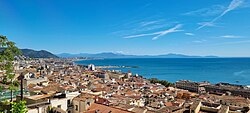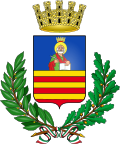https://www3.nhk.or.jp/nhkworld/en/live/
薩勒諾
薩利爾諾(那不勒斯)
市鎮
薩勒諾市
薩勒諾全景
薩勒諾全景
薩勒諾國旗
旗幟
薩勒諾的徽章
徽章
薩勒諾位於薩勒諾和坎帕尼亞省
薩勒諾位於薩勒諾和坎帕尼亞省
薩勒諾的位置
薩勒諾位於義大利薩勒諾薩勒諾
薩萊諾在義大利的位置
顯示義大利地圖
顯示坎帕尼亞地圖
全部顯示
座標:40°40′50″N 14°45′34″E
國家 義大利
坎帕尼亞大區
薩萊諾省 (SA)
成立於西元前 197 年
政府
• 市長 Vincenzo Napoli (PD)
面積[1]
• 全部的
58.96平方公里(22.76平方英哩)
海拔 4 公尺(13 英尺)
人口(2025年)[2]
• 全部的
125,958
• 密度 2,100/km2(5,500/sq mi)
德莫尼姆·薩勒尼塔諾
時區 UTC+1 (CET)
• 夏季(夏令時間)UTC+2(歐洲中部夏令時間)
郵遞區號
84121–84135
撥號代碼 089
守護神聖馬太
網站 官方網站
薩勒諾(英國:/sæˈlɛərnoʊ/,[3] 美國:/səˈ-, sɑːˈ-, səˈlɜːrnoʊ/;[4][5][6] 義大利語:[saˈlɛrno] ⓘ;那不勒斯; [saˈljernə])是義大利西南部坎帕尼亞大區的一座古城和市鎮,也是同名省的首府,是該地區人口第二多的城市,僅次於那不勒斯。 [7]它位於第勒尼安海的薩勒諾灣。在近代歷史上,這座城市曾是義大利國王維克托·伊曼紐爾三世的住所,在義大利與第二次世界大戰中的盟軍達成和平協議後,他於 1943 年從羅馬遷往薩勒諾,使薩勒諾成為「南方政府」(Regno del Sud)的首都,並因此成為臨時政府所在地(事實上的首都)六個月,因此曾是義大利首都的首都。雪崩行動(入侵義大利)期間,盟軍的部分登陸地點位於薩勒諾附近。截至 2025 年,該市有居民 125,958 人。 [2]
薩勒諾的人類定居有著豐富多彩的歷史,可以追溯到史前時代。在中世紀早期,它是一個獨立的倫巴第公國,即薩勒諾公國,大約在 11 世紀,它涵蓋了義大利南部的大部分地區。在此期間,世界上第一所醫學院—薩勒尼塔納醫學院 (Schola Medica Salernitana) 成立。 1077 年,諾曼人將薩勒諾定為其統治整個義大利南部大陸的首都。 16世紀,在義大利南部最有權勢的封建領主之一聖塞維裡諾家族的統治下,這座城市成為了學習、文化和藝術的重要中心,該家族僱用了當時幾位最偉大的知識分子。 [8]後來,1694年,這座城市遭受了幾起災難性的地震和瘟疫。 [8]在西班牙統治時期,這座城市經歷了一場持續到 18 世紀的危機,但在拿破崙的統治下,薩勒諾成為帕特諾皮亞共和國的一部分。 [8] 19 世紀,薩勒諾支持義大利復興運動的思想,並於 1861 年歡迎加里波第。
城市分為三個不同的區域:中世紀區、 19 世紀區和人口較稠密的戰後區,戰後區有幾棟公寓大樓。 [8]薩勒諾的守護神聖馬太使徒,其聖物保存於薩勒諾大教堂的地下室。
歷史
有關時間順序的指南,請參閱薩勒諾時間軸。
史前和古代
現在的薩勒諾地區自史前時代以來就一直有人定居,新石器時代木乃伊的發現可以證明這一點。 [9]該地區居住著講奧斯坎語的居民,並被伊特魯裡亞人殖民,他們在公元前 6 世紀在伊爾諾河對岸建立了伊恩蒂城,即今天的弗拉特城區,作為他們在坎帕尼亞基本上複製的十二城政治模式的一部分。該定居點是伊特魯裡亞人與附近的希臘殖民地波西多尼亞和埃利亞進行貿易的重要基地。西元前 5 世紀左右,庫邁戰役 (西元前 474 年) 後,薩莫奈人佔領了該地,並將其納入敘拉古勢力範圍。
隨著羅馬軍隊向坎帕尼亞挺進,伊爾納開始失去其重要性,被新的羅馬殖民地(公元前 197 年)薩勒諾姆所取代,該殖民地圍繞著最初的堡壘發展起來。這座新城市逐漸失去了軍事功能,轉而成為貿易中心,透過波皮利亞大道與羅馬相連,波皮利亞大道通往盧卡尼亞和雷焦卡拉布里亞。
Salerno Salierno (Neapolitan) | |
|---|---|
| Comune di Salerno | |
 Panorama of Salerno | |
 Salerno within the Province of Salerno and Campania | |
Location of Salerno | |
| Coordinates: 40°40′50″N 14°45′34″E | |
| Country | Italy |
| Region | Campania |
| Province | Salerno (SA) |
| Founded | 197 BC |
| Government | |
| • Mayor | Vincenzo Napoli (PD) |
| Area | |
• Total | 58.96 km2 (22.76 sq mi) |
| Elevation | 4 m (13 ft) |
| Population (2025)[2] | |
• Total | 125,958 |
| • Density | 2,100/km2 (5,500/sq mi) |
| Demonym | Salernitano |
| Time zone | UTC+1 (CET) |
| • Summer (DST) | UTC+2 (CEST) |
| Postal code | 84121–84135 |
| Dialing code | 089 |
| Patron saint | Saint Matthew |
| Website | Official website |
Salerno (UK: /sæˈlɛərnoʊ/,[3] US: /səˈ-, sɑːˈ-, səˈlɜːrnoʊ/;[4][5][6] Italian: [saˈlɛrno] ⓘ; Neapolitan: Salierno [saˈljernə]) is an ancient city and comune (municipality) in Campania, southwestern Italy, and is the capital of the namesake province, being the second largest city in the region by number of inhabitants, after Naples.[7] It is located on the Gulf of Salerno on the Tyrrhenian Sea. In recent history the city hosted Victor Emmanuel III, the King of Italy, who moved from Rome in 1943 after Italy negotiated a peace with the Allies in World War II, making Salerno the capital of the "Government of the South" (Regno del Sud) and therefore provisional government seat (and de facto Capital) for six months and so Former capitals of Italy. Some of the Allied landings during Operation Avalanche (the invasion of Italy) occurred near Salerno. It has 125,958 inhabitants as of 2025.[2]
Human settlement at Salerno has a rich and vibrant past, dating back to pre-historic times. In the early Middle Ages it was an independent Lombard principality, the Principality of Salerno, which around the 11th century comprised most of Southern Italy. During this time, the Schola Medica Salernitana, the first medical school in the world, was founded. The Normans in 1077 made Salerno the capital of their rule in all continental southern Italy. In the 16th century, under the Sanseverino family, among the most powerful feudal lords in southern Italy, the city became a great centre of learning, culture and the arts, and the family hired several of the greatest intellectuals of the time.[8] Later, in 1694, the city was struck by several catastrophic earthquakes and plagues.[8] During a period of Spanish rule the city suffered a crisis which would last until the 18th century, but under Napoleon Salerno became part of the Parthenopean Republic.[8] In the 19th century Salerno supported ideas of the Risorgimento and welcomed Garibaldi in 1861.
The city is divided into three distinct zones: the medieval sector, the 19th century sector and the more densely populated post-war area, with its several apartment blocks.[8] A patron saint of Salerno is Saint Matthew, the Apostle, whose relics are kept here at the crypt of Salerno Cathedral.
History
[edit]Prehistory and antiquity
[edit]The area of what is now Salerno has been continuously settled since pre-historical times, as the discoveries of Neolithic mummy remains documents.[9] Inhabited by Oscan-speaking populations, the region was colonized by the Etruscans, who founded the city of Irnthi in the 6th century BC, across the Irno river, in what is today city quarter of Fratte, as a part of their Dodecapolis political model they essentially replicated in Campania. This settlement represented an important base for Etruscan trade with the nearby Greek colonies of Posidonia and Elea. It was occupied by the Samnites around the 5th century BC as a consequence of the Battle of Cumae (474 BC) as part of the Syracusan sphere of influence.
With the Roman advance in Campania, Irna began to lose its importance, being supplanted by the new Roman colony (197 BC) of Salernum, developing around an initial castrum. The new city, which gradually lost its military function in favour of its role as a trade centre, was connected to Rome by the Via Popilia, which ran towards Lucania and Reggio Calabria.




沒有留言:
張貼留言
注意:只有此網誌的成員可以留言。